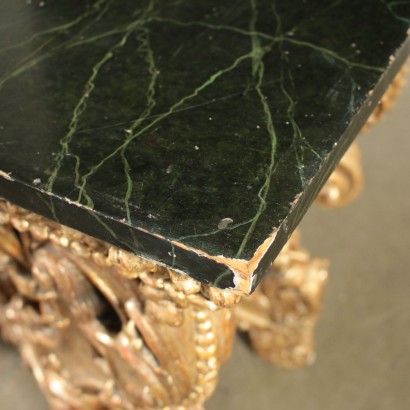Console carved and gilded
Features
Style: Baroque (1630-1730)
Age: 18th Century / 1701 - 1800
Origin: Austria
Description
Table wall with posts arranged to X with respect to the plane with a cruise in the base are carved, which connects with a flat surface. The uprights consist of two large C contrasting with a fretwork with leaves and masks placed above the foot on the curls, the front of the under floor of the two spirals are connected in a large lambrecchino front; under - floor a carved frame of leaves subsequent. The entire surface is golden and the funds are carved and engraved to triage in the plaster preparation. The floor in the faux marble has been replaced at a different time.
Product Condition:
Product in good condition, has small signs of wear and tear.
Dimensions (cm):
Height: 87
Width: 131
Depth: 64
Additional Information
Notes historical bibliographic
Similar patterns are present in the palaces and museums are found on the bibliography of relevance. The translation of the baroque, which makes this region of Europe is a less monumental in both measures in the choices of the reasons for carving. The Italian region that more crosses the two styles may not that be the area in veneto, in trentino, where it is very much like the carving and the use of the engraving burin and the surface of the bottom.Style: Baroque (1630-1730)
Read more
The term derives from the Spanish barrueco phoneme or Portuguese barroco and literally means "shapeless pearl".
Already around the middle of the eighteenth century in France it was synonymous with uneven, irregular, bizarre, while in Italy the term was of Medieval memory and indicated a figure of the syllogism, an abstraction of thought.
This historical period was identified with the derogatory term baroque, recognizing in it extravagance and contrast with the criteria of harmony and expressive rigor to which it was intended to return under the influence of Greco-Roman art and the Italian Renaissance.
Baroque, seventeenth-century and seventeenth-century were synonymous with bad taste.
As regards furniture, freedom of ideation, need for pomp and virtuosity gave rise to a synergy destined to produce unsurpassed masterpieces.
The materials used were worthy of competing with the most astonishing tales of Marco Polo: lapis lazuli, malachite, amber, ivory, tortoiseshell, gold, silver, steel, precious wood essences and more dressed the furnishings that in shape and imagination virtually gave life to the Arabian Nights of many of our powerful people.
Typical of the period were load-bearing or accessory parts resolved with twisted column motifs, clearly inspired by Bernini's canopy of St. Peter's, parts with rich sculptural carving in high relief and even in the round within a vortex of volutes, scrolls and spirals, curved and broken profiles, cymatiums agitated by gables of articulated shape, aprons adorned with ornaments, corbels, buttresses and so on. necessary to enliven shapes and structures.
The Baroque is also the century of illusionism: lacquers and thin temperas crowd furniture and furnishings to imitate with the marbling effects of marble veining or games of veining of precious briar roots.
Find out more about the Baroque with our insights:
Classic Monday: a double-body sideboard, late Venetian Baroque
Classic Monday: a pair of candle holders between the Renaissance and Baroque
Classic Monday: a pair of mirrors between Baroque and Late Baroque




























